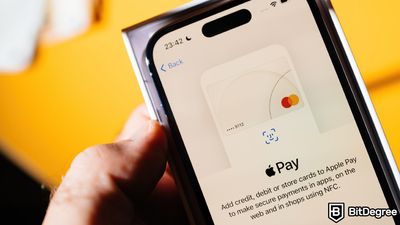Key Takeaways
- Double-spending is a type of crypto theft attack where the hacker tries to spend the same crypto funds twice by creating a second, invalid transaction;
- There are different types of double-spending attacks, such as 51% attacks, race attacks, and Finney attacks;
- Blockchains prevent double-spending by utilizing a consensus mechanism, timestamping, and other strategies.
Stop overpaying - start transferring money with Ogvio. Sign up, invite friends & grab Rewards now! 🎁
Cryptocurrency has its fair share of advantages over traditional finance, but even its most ardent fans won’t deny there’s the other side of the coin to consider (no pun intended!). The decentralized nature of blockchain, combined with its digital architecture, puts it at risk of one particular phenomenon. What is double-spending in blockchain, and why should you care about it?
In a nutshell, double-spending means exactly what you probably thought it does: trying to spend the same crypto assets twice, which is essentially equivalent to using forged money. It’s not something you could easily get away with on centralized exchanges like Binance or Kraken, since they have their own internal ledger of users’ balances and transactions, but it can potentially be a problem in the DeFi scene.
If you’ve never heard of this before, buckle up – you’re in for an illuminating read! Find out everything you need to know about the double-spending problem, its causes, case examples, and the solutions practiced by the most successful blockchains like Bitcoin.

Did you know?
Subscribe - We publish new crypto explainer videos every week!
What is a Liquidity Pool in Crypto? (Animated)


Table of Contents
- 1. What is Double-Spending in Blockchain?
- 1.1. A Primer on Blockchain: How Do Crypto Transactions Work?
- 1.2. Bitcoin Double-Spending: An Example in Detail
- 1.3. The Consequences
- 2. Has Blockchain Double-Spending Happened Before? Famous Real-Life Cases
- 2.1. The Bitcoin Gold Attack (2018)
- 2.2. The Ethereum Classic Attacks (2019 & 2020)
- 2.3. The Verge Crypto Attack (2018)
- 3. Types of Double-Spending Attacks
- 3.1. 51% Attacks
- 3.2. Race Attacks
- 3.3. Finney Attacks
- 4. How Do Blockchains Prevent Double-Spending?
- 4.1. Best Strategies
- 4.2. Future Challenges and Limitations
- 5. Conclusions
What is Double-Spending in Blockchain?
I’ve already introduced the gist of what double-spending means – but that was just scratching the surface. If you’re wondering how double-spending is even possible in the first place, it’s time to brush up on the general knowledge of how blockchain transactions work, so let’s rewind a bit and plug some context into the gaps.
Latest Deal Active Right Now:A Primer on Blockchain: How Do Crypto Transactions Work?
Blockchain is a decentralized ledger or database whose defining feature is that, unlike regular databases, its data is stored across multiple computers (called nodes) instead of a centralized server. A blockchain transaction, in turn, is a record of a transfer of value or data between parties (e.g., one user buying cryptocurrency from another user).

These transactions are recorded in blocks, and each block is linked to the one before it, creating a chain (hence the name "blockchain"). Every transaction sets off a chain of events from start to finish, which looks something like this:
1
Initiating a Transaction. When you initiate a transaction (like sending BTC from your wallet to someone else's), a new transaction is created with your wallet address, the recipient’s address, the amount of cryptocurrency being sent, and a digital signature (generated by the sender's private key, proving ownership of the assets).
2
Broadcasting the Transaction. The transaction is sent to the nodes (computers connected to the blockchain network), which store and propagate the transaction across the network. This step doesn’t mean the transaction is final; it’s just being spread around the network.
3
Verification and Validation. Miners (in PoW-based blockchains) or validators (in PoS-based blockchains) pick up these transactions and begin verifying their legitimacy, checking if the sender’s address and the digital signature are valid and whether the sender has enough balance to make the transaction.

4
Transaction is Included in a Block. After verification, the transaction is added to a block. The block is then added to the blockchain after being mined (PoW) or validated (PoS). Mining or validation involves confirming the legitimacy of the entire block and its transactions. Once it’s done, the transaction becomes part of the immutable ledger.
5
Confirmation and Finality. The more blocks are added after the block containing your transaction, the more secure the transaction becomes, making it harder for it to be altered or reversed. In most cases, the transaction is considered final, that is, fully secured and irreversible, after six confirmations (i.e., six additional blocks added after the one containing your transaction).
While there are a few more differences, depending on the type of consensus mechanism, this is more or less the way it works on any blockchain.
Curious to learn more about the workings of blockchain technology? This BitDegree Mission is one of the best interactive resources that rounds up the core concepts - and gives you up to 10,900 Bits for completing it!
Bitcoin Double-Spending: An Example in Detail
Now that you have the general idea of how blockchain transaction works, let’s come back to our topic in question: what is double-spending in blockchain, exactly?
As I’ll explain later, most double-spending attempts don't get very far: if they did, the entire concept of cryptocurrency probably wouldn’t exist in the first place! But let’s pretend this isn’t the case for a minute. If a malicious actor tries to fob someone off with a copy of their crypto funds, here’s what this would look like at the blockchain level.

To launch a double-spending attack, the hacker would have to create two conflicting transactions that attempt to spend the same cryptocurrency. For instance, they want to send 0.1 BTC and create:
- Transaction A to Wallet Address B;
- Transaction B to Wallet Address C.
These double-spending Bitcoin transactions would be broadcast to the blockchain network at the same time, or within a short period of each other, before they’re fully validated.
Both Transaction A and Transaction B are initially valid in isolation, since they both contain a valid signature from the attacker, and both transactions are attempting to spend the same 0.1 BTC. These transactions then enter the mempool (a temporary storage area for unconfirmed transactions), where they wait for the miner or validator to confirm them.

Under normal circumstances, the miners or validators would notice that same BTC being spent twice and reject the second conflicting transaction. But let’s humour this hypothetical double-spending example and assume they don’t. Here’s what happens next:
- The first miner/validator includes Transaction A in a block, confirming that 0.1 BTC was sent from the attacker’s wallet to Address B.
- A different miner/validator includes Transaction B in another block, confirming that the same 0.1 BTC was sent from the attacker’s wallet to Address C.
As a result, both addresses now seem to have received 0.1 BTC each, even though only one transaction is legitimate (the one that got validated first), meaning that one address with have the “real” 0.1 BTC, while the other will basically have an invalid copy.
The Consequences
If this scenario sounds like nightmare fuel, you’re not alone! What is double-spending in blockchain, if not a way to completely undermine the very idea of cryptocurrency as a legitimate payment method?
With enough cases of crypto users and vendors accepting cryptocurrency as payment getting defrauded, this would land a colossal blow to the reputation of crypto and blockchain in general. It’s not a massive leap to assume that this could eventually cause the price of even major cryptocurrencies like Bitcoin to plummet, threatening the crypto market as a whole.

When it comes to the architecture and performance of blockchain, double-spending can destabilize them through a phenomenon known as forking: if both transactions get temporarily accepted, it creates a situation where two versions of the blockchain exist, essentially splitting it. As you can imagine, this causes a lot of confusion for users.
There’s no need to give in to fearmongering, though! The good news is that blockchains have some pretty effective safeguards to prevent this sort of thing, and the trickery would get found out sooner or later. If you’re wondering, for instance, “How does Bitcoin prevent double-spending?”, I’ll tell you all about it in one of the sections below.
Has Blockchain Double-Spending Happened Before? Famous Real-Life Cases
I’m guessing you now have a pretty clear picture of, “What is double-spending in blockchain actually going to achieve?”, but let me address the elephant in the room: have any of those double-spending attacks succeeded before? Unfortunately, some have. Here are a few of the prominent cases the crypto community has weathered over the years.
The Bitcoin Gold Attack (2018)
One of the most notable double-spending examples was the infamous 51% attack of May 2018 that targeted Bitcoin Gold (BTG), a Bitcoin hard fork that was created to make mining less GPU-intensive so it was more accessible to regular users.
Earlier in this article, I mentioned forking as one of the undesirable outcomes of a double-spending attack – but blockchain forks can be launched on purpose for some other reasons, too, such as major network upgrades.
This network suffered a 51% hashing attack where a hacker gained control of the majority of its mining power and used it to create an alternate version of the blockchain. This allowed them to reverse confirmed transactions and steal 388,000 BTG from several crypto exchanges.
In the aftermath, Bitcoin Gold was delisted from Bittrex (one of the largest exchanges at the time) when the BTG team refused to pay half of the reparations for the losses. However, a few months later, the developers introduced a new mining algorithm to bolster the network’s security, so you could say there was some silver lining, after all.

Did you know?
Subscribe - We publish new crypto explainer videos every week!
Remittance Explained: Will This Newcomer Change the Game? (ANIMATED)


The Ethereum Classic Attacks (2019 & 2020)
To give you a bit of backstory at first: Ethereum Classic is actually the original Ethereum blockchain. After a hacking attack in 2016 that resulted in the theft of $50 million worth of crypto, Ethereum’s developers created a new hard fork of the mainnet. Not everyone switched, however; the users who decided to stay make up the Ethereum Classic community.

Which was probably for the worse, given that, in January 2019, Ethereum Classic came under a double-spending attack that stole about $1.1 million worth of ETC tokens. And it seems like the blockchain just couldn’t catch a break: in August 2020, it suffered three more attacks, with a total of ~15,000 blocks reorganized.
Just like Bitcoin Gold, though, Ethereum Classic didn’t take all this lying down. It ended up adopting a modified version of the Ethash proof-of-work (PoW) consensus algorithm, known as ETChash.
The Verge Crypto Attack (2018)
As it turned out, 2018 really was a lousy year for crypto security. Verge (XVG), a privacy-focused token, experienced not one, but several double-spending attacks. The hackers took over Verge’s Proof-of-Work consensus mechanism and stole an estimated $1.7 million worth of XVG tokens.
Verge’s PoW mechanism actually consisted of five algorithms (Scrypt, X17, Lyra2rev2, Myr-Groestl, and BLAKE2s) to promote egalitarian access to mining. Instead of reinforcing the network’s security, however, this hybrid approach had one fatal flaw: instead of requiring miners to distribute hash power evenly across all five algorithms, Verge allowed any single algorithm to meet the hash rate threshold for confirming blocks.

You can probably guess what happened next: the attackers exploited this by disproportionately targeting just the Scrypt algorithm, renting mining rigs to acquire over 50% control of the Scrypt hash rate. This gave them de facto control of the overall network consensus.
After the “coup”, they first sent XVG to exchanges and swapped it for BTC, and once exchanges confirmed the deposits, the attackers forked the Verge chain to erase the transactions (rolling back the blockchain before the XVG deposits as if they never happened).
Types of Double-Spending Attacks
I’ve covered the actual process of double-spending on a granular level – but now it’s time to zoom out. When it comes to blockchain, double-spending can take multiple forms and approaches, depending on what resources the attacker has at their disposal or what kind of blockchain they’re targeting.
51% Attacks
Most of the double-spending examples I mentioned in the previous section utilized this type of attack, so let’s start here. As the name suggests, it’s based on the fact that having control over more than 50% of the network’s mining power (also called hash rate) allows you to create an alternative chain and have your way with it: freely edit existing data blocks, approve double-spending transactions, and steal assets.

51% attacks are mostly used against smaller blockchains with fewer validators, since the more nodes a blockchain has, the harder it is to pull it off. A network like Ethereum, with a total of 11,357 nodes (as of July 14, 2025), would be pretty much impervious to a 51% attack.
That's not to say even the biggest blockchains are completely safe, though. Some experts point out the growing issue of centralization (a small number of miners owning a disproportionately large percent of the hash rate). In January 2014, a Bitcoin mining group GHash.IO collectively reached 42% of the network's total hash power,[1] which came scarily close to the 51% threshold.
For a deeper dive into blockchain security and 51% attacks, check out this BitDegree Mission and earn up to 6,500 Bits for completing it!
Race Attacks
If 51% attacks are so resource-intensive, you might ask – what’s the opposite alternative? That’s where race attacks enter the picture. Contrary to 51% attacks, these are based entirely on speed, not power. The way it works is: the attacker sends two conflicting transactions at the same time, one of which goes to a vendor and another to their own address.

Race attacks exploit the time delay between transaction broadcasting and confirmation. Their effectiveness relies on the fact that different parts of the network receive transactions at slightly different times. With the right timing, the attacker can make sure that the transaction sent to their address is confirmed first, which means that the merchant accepts the invalid coins, while the thief essentially gets a refund.
As you can imagine, the solutions to race attacks depend on patching up two main issues: transaction delay and the number of confirmations required. Shortening the time between blocks can reduce the window of opportunity for race attacks. However, slower blockchains (like Bitcoin, which produces a new block every 10 minutes) need more confirmations for the same level of security.
Finney Attacks
Yet another form of double-spending, a Finney attack is a sort of bait-and-switch tactic where, instead of broadcasting a transaction, the attacker mines it privately and only broadcasts it after using the mined crypto to pay for their purchase. Once they get what they’ve bought, the attacker broadcasts their previously mined block, and just like that, the transaction sent to the merchant becomes invalid.

Finney attacks involve three wallet addresses: two that belong to the attacker (so they can create the first transaction by sending their crypto from one wallet to another), and the merchant’s wallet address. Basically, what happens is that they spend the same coins in a separate transaction while having a “backup” transaction ready to invalidate it.
This type of attack falls somewhere in the middle between 51% and race attacks in terms of entry barrier. You’d have to be a miner to pull it off, but it only takes enough mining power to pre-mine one block – no need to hijack half of the blockchain for this one! On the other end, the merchant would have to accept transactions with zero confirmations.
How Do Blockchains Prevent Double-Spending?
Given that the blockchain technology is still very much alive and thriving, it’s clear that the double-spending problem has been taken care of, for the most part. Now that we've got “What is double-spending in blockchain?” out of the way, let’s move on to the “solutions” part of the story. How does Bitcoin prevent double-spending? What strategies work best for other networks?
Best Strategies
As with most other types of defence, different methods of double-spending prevention aren’t just used in isolation – they work best as part of a package. Still, if someone were to ask, “What is THE method to prevent double-spending called?”, the role of the consensus mechanism would definitely deserve the top spot.

Since blockchains don’t have any central authority overseeing them, the consensus mechanism acts as the backbone of their security by:
- deciding which transactions get added to the blockchain and in what order;
- ensuring that all nodes in the network agree on a single, consistent version of the ledger.
The two most popular types of consensus mechanisms are Proof-of-Work (PoW) and Proof-of-Stake (PoS). In PoW blockchains (like Bitcoin), miners solve a cryptographic puzzle to add a new block, while the PoS mechanism consists of validators (participants with a certain amount of staked crypto) who get randomly selected to confirm transactions and create new blocks.
With the consensus mechanism acting as a gatekeeper, most types of double-spending would be practically impossible to get away with.

Having said that, there's one potential pitfall: Bitcoin miners are more likely to prioritize confirming high-value transactions that offer a higher fee.[2] When the network is under heavy load, low-value transactions might sit in the mempool unconfirmed for too long, which opens a window of opportunity for double-spending.
Timestamping is another obvious solution to boost the blockchain’s defences against double-spending. It does exactly what it says on the tin: every new block comes with a record of the exact date and time it was created, which clears up any confusion on the chronological order of those transactions – meaning that a malicious actor couldn’t pass off a second identical transaction as valid.
51% attacks in particular require a lot of mining power – so it only makes sense to tackle double-spending from that angle and raise the entry barrier for node operation. I already mentioned Ethereum as a prime example here: if someone had to own what amounts to thousands of USD worth of tokens to become a validator, they’d probably think twice about trying!

All of these approaches are basically the bread and butter of thwarting double-spending on the end of the blockchain itself, but let’s not forget about the other party. Merchants and vendors can nip double-spending in the bud by:
- Requiring more confirmations (especially for higher-value transactions);
- Utilizing reliable payment processors;
- Monitoring the mempool with APIs or blockchain explorer tools to detect unconfirmed transactions.
Finally, I’ve already hinted at the number of confirmations and how they relate to the security of a blockchain, but it still bears repeating. In a nutshell, there’s an inverse relationship between how long it takes for a network to mine or validate a new block and the number of confirmations required for adequate security.
Blockchains like Solana that are known for their blazing-fast transactions (only 0.4-0.5 seconds for a new block) can get away with having only 1-2 confirmations. Next to that, Bitcoin’s 10-minute confirmation time looks positively glacial – which is why you need as many as 6 confirmations to ensure validity.

- Secure and reliable
- Accepts fiat currencies
- Lots of trading options
- Reputable exchange
- Accepts fiat currencies
- Offers various trading options

- Huge trading variety
- Regulation-compliant around the globe
- Fair trading fees
- Beginner-friendly
- A wide array of features
- Vast number of different crypto coins & tokens

- Beginner-friendly
- Secure
- Decent trading and withdrawal fees
- Crypto.com Visa Card
- Automated tools & bots
- Ecosystem synergy with CRO
Future Challenges and Limitations
Major networks might have a handle on our problem in question at the moment, but what is double-spending in blockchain going to look like five or ten years from now? As with any other type of technology, it boils down to an arms race between the blockchains and their attackers.
Here are just a few areas that could potentially become the new battleground for double-spending:
- Layer-2 Networks. L2 networks are designed to offload transactions from the main chain, improving their speed and lowering the network fees. However, those transactions are first recorded off-chain and rely on different mechanisms (state channels, fraud proofs, or rollup validators) for security, which double-spending attacks could exploit.
- Cross-Chain Bridges. Cross-chain protocols (e.g., wrapped tokens and bridges) rely on validators or smart contracts. If a bridge is compromised, a user could attempt simultaneous transfers on multiple chains, effectively double-spending assets across ecosystems.
- Quantum Computing. Quantum computers might become a serious threat to the PoW-based blockchains that rely on solving cryptographic puzzles.
While there’s no need to sound alarm bells just yet, blockchain developers will definitely need to stay vigilant and keep up with the latest developments to stave off double-spending becoming an issue to be reckoned with.
📚 Learn More: Quantum Computing and Crypto: Is Bitcoin at Risk?
Conclusions
What is double-spending in blockchain? Is it a serious threat, and if so, what are blockchains doing to prevent it? A guide like this one could still only scratch the surface of all there is to know on the topic, but hopefully, it gave you enough background to know where to go next.
As a regular crypto user, double-spending is probably not something you should lose any sleep over, but blockchains as a whole can be (and have been) affected by it. The verdict is still out on whether factors like quantum computing or the growing popularity of Layer-2 networks and cross-bridging protocols will play a role in making double-spending more prevalent.
The content published on this website is not aimed to give any kind of financial, investment, trading, or any other form of advice. BitDegree.org does not endorse or suggest you to buy, sell or hold any kind of cryptocurrency. Before making financial investment decisions, do consult your financial advisor.
Scientific References
1. Aponte-Novoa F. A., Orozco A. L. S., Villanueva-Polanco R., Wightman P.: 'The 51% Attack on Blockchains: A Mining Behavior Study';
2. Malakhov I., Marin A., Rossi S.: 'Analysis of the confirmation time in proof-of-work blockchains'.









